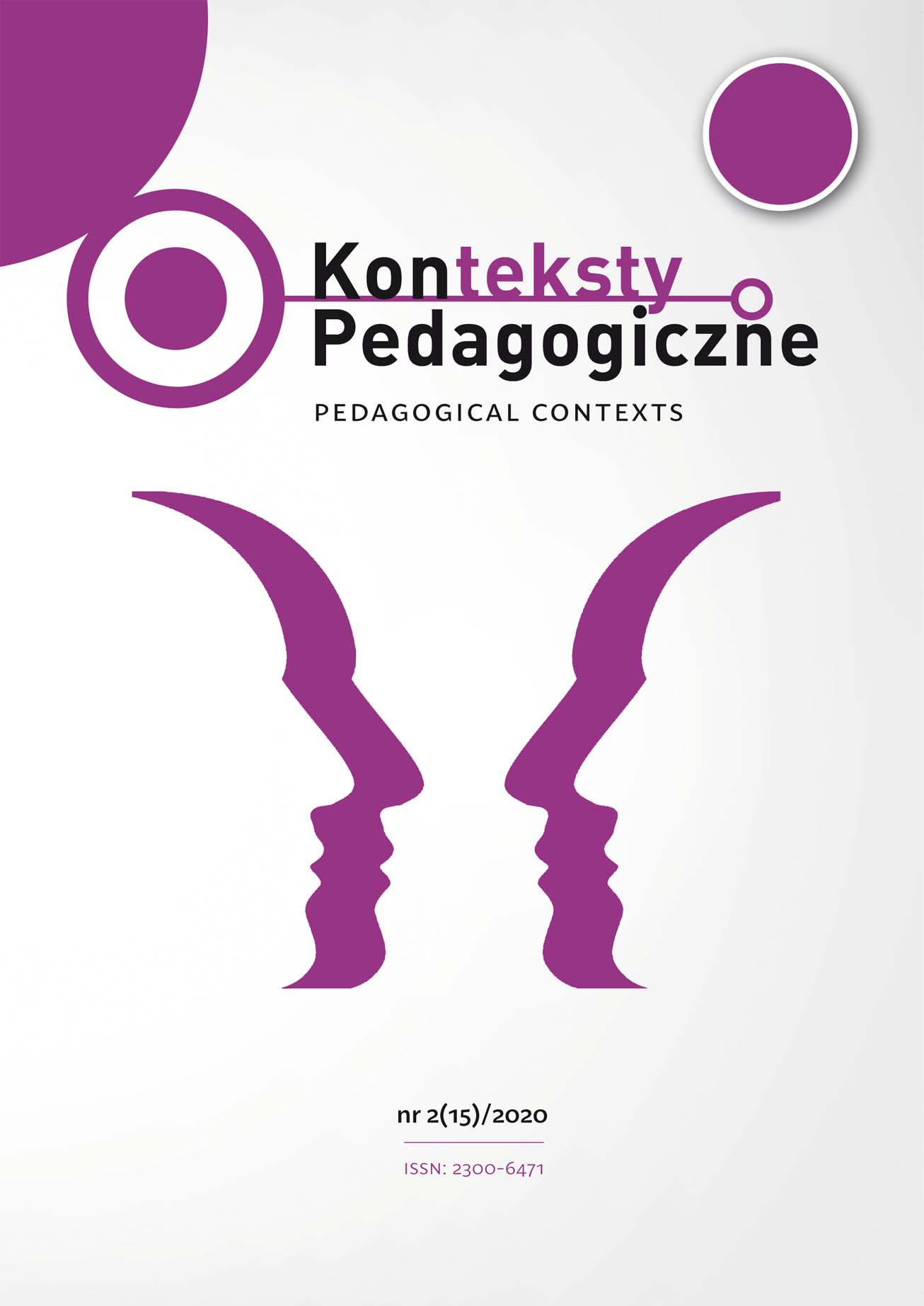Abstract
The article presents the assumptions and results of a natural pedagogical quasi-experiment which was carried out with children in grades 1–3 of primary school. The aim of the transverse research was to present a method that was to arouse the interest of the children in graphics and its means of artistic expression (line, blotch, black and white). The experimental factor was using the method of didactic play of a creative nature which consisted of an illustrative story developed by the author entitled “Black and White” and the content of the poem “Black Line.” The final stage of the experiment was the children’s work in the graphic technique of linocut. A quantitative analysis of the test results obtained by individual groups of children from grades 1, 2 and 3 (percentage distribution of the obtained test results in the experimental and control groups) was performed. The obtained results confirmed the assumptions and hypothesis of the research because the introduction of the creative play incited children’s interest in graphics. On the other hand, in grade 3, the children from the experimental group obtained a slightly (by 2%) lower result than the control group. This may indicate the need to change the method of art education for children in this age group and the beginning of a crisis in the development of their artistic creativity.
References
Bruner, J.S. (1978). Poza dostarczone informacje. Studia z psychologii poznania [Beyond the Information Given], transl. B. Mroziak. Warszawa: PWN.
Daszyńska, M. (1992). Techniki graficzne powielane i odbijane [Graphic Techniques Copied and Reflected]. Warszawa: WSiP.
Gloton, R. & Clero, C. (1985). Twórcza aktywność dziecka [Creative Activity of the Child], transl. I. Wojnar. Warszawa: WSiP.
Gurycka, A. (1978). Rozwój i kształtowanie zainteresowań [Development and the Shaping of Interests]. Warszawa: WSiP.
Hurlock, E. (1985). Rozwój dziecka [Child Development], Vol. 1–2, transl. M. Tyszkowa. Warszawa: PWN.
Jakimowicz, I. (1961). Polska grafika współczesna [Polish Contemporary Graphics]. Warszawa: WAiF.
Jurkiewicz, A. (1975). Podręcznik metod grafiki artystycznej [Handbook of Artistic Graphics Methods]. Warszawa: Arkady.
Krejča, A. (1984). Techniki sztuk graficznych [Graphic Arts Techniques]. Warszawa: WAiF.
Lowenfeld, V. & Brittain, W.L. (1977). Twórczość a rozwój umysłowy dziecka [Creative and Mental Growth], transl. K. Polakowski. Warszawa: PWN.
Okoń, W. (1950). O zabawach dzieci [On Children’s Play]. Warszawa: PZWS.
Okoń, W. (1955). Rodzaje zabaw dziecięcych i ich właściwości [Types of Children’s Play and Their Properties]. Warszawa: PZWS.
Okoń, W. (1995). Zabawa a rzeczywistość [Play and Reality]. Warszawa: Żak.
Porębski, M. (1974). Era grafiki [The Era of Graphics]. In: T. Hrankowska (ed.), Grafika wczoraj i dziś [Graphics Yesterday and Today] (pp. 5–19). Warszawa: PWN.
Przetacznikowa, M. & Spionek, H. (1976). Współczesne poglądy na zabawę dziecka [Contemporary Views on the Child’s Play]. In: M. Żebrowska (ed.), Psychologia rozwojowa dzieci i młodzieży [Developmental Psychology of Children and Adolescents] (pp. 358–373). Warszawa: PWN.
Stopczyk, S. (1971). Spotkania z grafiką [Meetings with Graphics]. Warszawa: PZWS.
Szuman, S. (1947). Psychologia wychowawcza wieku dziecięcego [Childhood Educational Psychology]. Warszawa: IW NK.
Szuman, S. (1948). Rozwój psychiczny dzieci i młodzieży [Mental Development of Children and Adolescents]. Warszawa: NK.
Szuman, S. (1955). Rola działania w rozwoju umysłowym małego dziecka [The Role of Activity in the Mental Development of a Small Child]. In: S. Szuman, Dzieła wybrane [Selected Works], Vol. 1: Studia nad rozwojem psychicznym dziecka [Studies on the Psychological Development of a Child] (pp. 58–170). Warszawa: WSiP.
Szuman, S. (1985). Rola działania w rozwoju umysłowym małego dziecka. In: S. Szuman, Dzieła wybrane, Vol. 1: Studia nad rozwojem psychicznym dziecka (pp. 58–170). Warszawa: WSiP.
Tomaszewski, T. (ed.) (1977). Psychologia [Psychology]. Warszawa: PWN.
Wejman, M. (1970). Katalog. III Międzynarodowe Biennale Grafiki [Catalog. 3rd International Graphic Biennial]. Kraków: BWA.
Werner, J. (1981). Podstawy technologii malarstwa i grafiki [Fundamentals of Painting and Graphics Technology]. Warszawa–Kraków: PWN.
Vygotsky, L.S. (1978). Narzędzie i znak w rozwoju dziecka [Tool and Symbol in Child Development], transl. B. Grell. Warszawa: PWN.
Vygotsky, L.S. (2006). Narzędzie i znak w rozwoju dziecka [Tool and Symbol in Child Development], ed. 2 as amended, transl. B. Grell. Warszawa: PWN.
In accordance with the recommendation of the Ministry of Science and Higher Education, which aims to counteract the practice of “ghostwriting” and “guest authorship,” all authors submitting their text for publication should attach an author’s statement which declares the contribution of each of the authors to the article. The printed and signed statement should be delivered by mail or other means to editor-in-chief Joanna Skibska or sent in the form of a scan to the following e-mail address: redakcja@kontekstypedagogczne.pl. The authors will not receive remuneration for publishing their papers. The editors reserve the right to make minor editorial changes to the articles which will not affect the substance of the article. We encourage all authors to prepare their articles in accordance with the guidelines for manuscript preparation. Download pdf file.
Authors transfer all copyrights and grant the journal the right of first publication with the work simultaneously licensed under a Creative Commons Attribution License that allows others to share the work with acknowledgement of the work's authorship and initial publication in this journal. All authors agree to the publishing of their email addresses, affiliations and short bio statements with their articles during the submission process.

